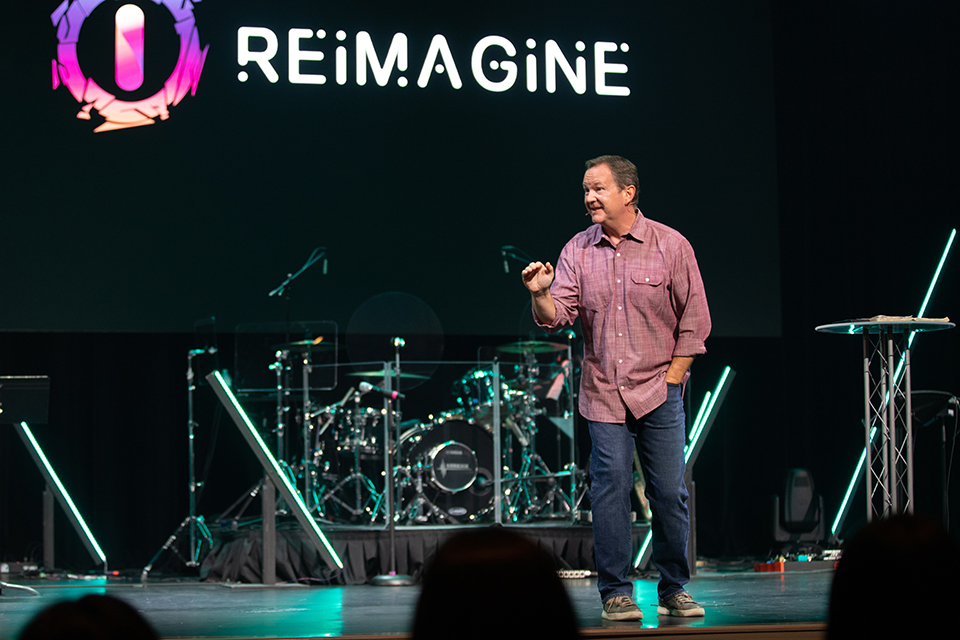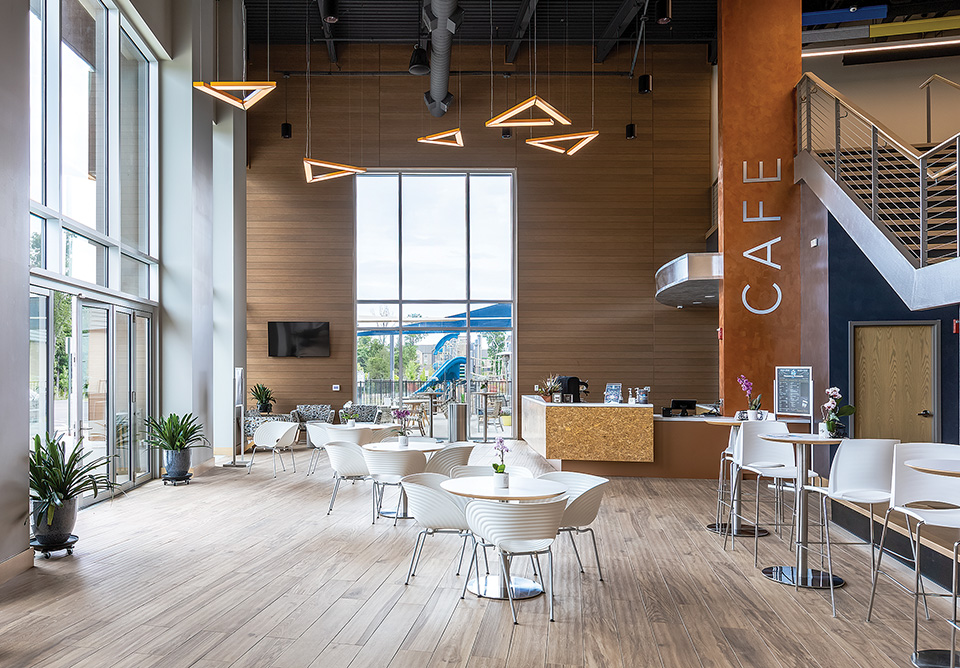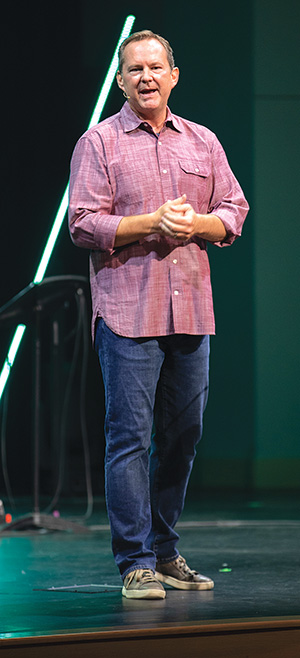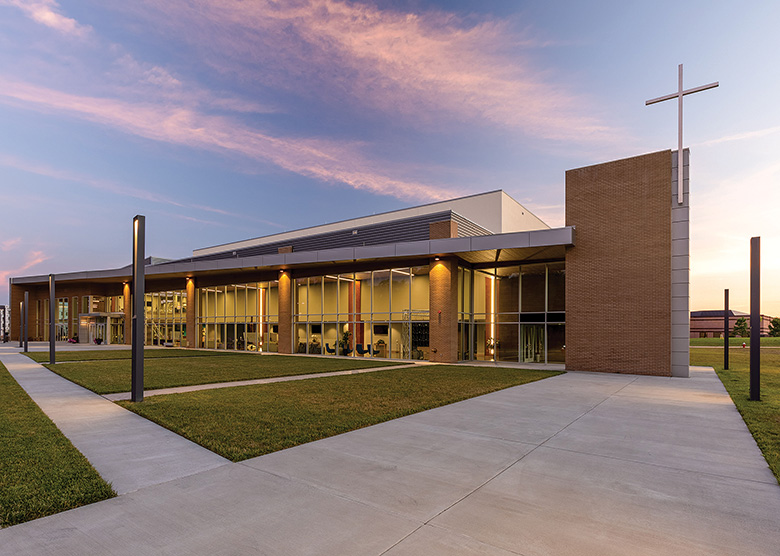
By RaeAnn Slaybaugh
BRIAN BALES / LEAD PASTOR / CHRISTIAN FELLOWSHIP CHURCH / ASHBURN, VA
The new Christian Fellowship Church (Building) in Ashburn, Va., took many of its unique, contemporary style cues from the surrounding community
Over 30+ years, leaders at Christian Fellowship Church grew adept at making ministry work in a former manufacturing facility in Loudoun County, Va.
Now, with their new, $25-million facility in nearby Ashburn — which sits directly adjacent to the popular One Loudoun mixed-use community — church leaders are relishing a facility that suits them (and their neighbors) to a T.
Back in the 1990s, leaders at Christian Fellowship Church set their sights on expanding in their home area of Fairfax County, Va. Ultimately, however, county officials and CFC leaders were unable to reach an agreement.
So, CFC leaders opened their minds to something … different.
Several miles away, in Loudoun County, sat a vacant, 225,000-square-foot manufacturing facility on 22 acres. Though it would take significant work to make it functional for church use, the property was available for pennies on the dollar due to a massive economic downturn at the time.

 “From the outside, it just looked like a regular building,” says CFC Lead Pastor Brian Bales. “Whatever a church is supposed to look like, it didn’t.”
“From the outside, it just looked like a regular building,” says CFC Lead Pastor Brian Bales. “Whatever a church is supposed to look like, it didn’t.”
As it turns out, that wasn’t an issue.
For one thing, Bales believes that a church building is a tool, at best. “It can’t do what God made His people to do,” he explains. “The building is not a magic bullet.”
In fact, the nondescript façade and vastness of the Loudoun County church property actually added to its appeal over the years while it became part of what was known as Data Center Alley.
“Our running joke is that we’re like The Beverly Hillbillies: ‘up from the ground comes bubbling crude,’” Bales laughs. “What ultimately made our property valuable had zero to do with why we bought it.”
Over the years, he and his team regularly fielded inquiries from developers who wanted to buy the property and use it as a data center. When CFC leaders finally decided to sell it and relocate, they set their sights on nearby One Loudoun, a lifestyle mixed-use community in Ashburn within five driving miles.
Before the property could be sold, CFC would need to secure a new church home. Everything was contingent on that. They found just what they were looking for in a 22-acre parcel that shares a property line with One Loudoun. But first things first.

Given Bales’ overriding focus on debt retirement, the goals were ambitious: pay off the church’s existing debt — accumulated over decades spent repairing and maintaining decades-old A/C units, refacing parking lots, and so on — as well as relocate to One Loudoun and build the brand-new church.
The sale of the building went a long way towards achieving these goals.
Additionally, because 22 acres was more land than CFC needed (but the owner wouldn’t split it up), church leaders sold nine acres to a developer and kept 13 acres. The nine acres the church sold were built up with a mix of four-story buildings that house condominiums and townhomes.
Building on a firm foundation
With a blank slate on their hands, Bales and his team knew one thing for sure: the new church must reflect the look and feel of the eclectic community of One Loudoun.
“It has restaurants. It has Barnes & Noble. It’s like a downtown center,” he explains. “Everyone walks here — including our people, to church. And then they walk to dinner afterwards.”
“When people made it to our property line, we didn’t want them to look at our building and say, ‘Oh, this doesn’t belong here.’ We wanted to communicate, ‘You are welcome here, and we’re part of the community,’” he adds.
It was a tall order, and the church’s vetting of architects reflects that fact.
The search started even before the previous property was sold. Spurred by the steady stream of inquiries from potential buyers, Bales and his team talked with several design-build firms and local architects about building a new church. Additionally, they consulted with an out-of-state firm that was behind one of CFC’s partner church projects: HH Architects, based in Dallas.

To thoroughly vet all these prospects, CFC leaders called upon high-end project managers in the congregation to develop a Gantt chart for the new church. This is a document used to help building teams establish deadlines and properly allocate resources, providing a bird’s eye view of a project.

Such a detailed level of planning was crucial because CFC needed to be moving into the new building while moving out of the old one. “If we weren’t out at a certain time, it was going to cost us money to move all our stuff out to a different place,” Bales explains. “That would have significant financial impact.”
The Gantt chart was shared with potential building partners and architects. Bales simply said to each: This is our timeline. Can you do it?
“Every single one of them said, ‘This is tight. Churches can’t normally do this tight of a timeline,’” he recalls. “And I said, ‘That’s not my question.’”
HH Architects committed to meeting the timeline. And while this was one reason CFC leaders selected the firm, three other factors were also at play.
First, the portfolio.
As mentioned, the church wouldn’t consider building anything “cookie-cutter.” To this end, Bales says, HH Architects’ portfolio was diverse compared with the other firms’ work, all of which he found to be predictably recognizable.
“Their churches were good, but I could tell they did every one of those buildings,” he recalls. “For us to look uniquely like our community, we wanted to work with a firm that had the ability to look at what we were asking, look at our community, and create something that wasn’t already in a box of ‘how we do things,’ if that makes sense.”
Next, Bales says, he appreciated HH Architects’ understanding of how church is done.
“When we walked through issues in the planning stage, they understood how a church functioned on a Sunday and on a Wednesday,” he says. “They understood movement of people in an actual, not a theoretical, way.”
Finally, Bales says that HH’s pricing structure was very competitive, even with travel expenses. (Indeed, many meetings and much planning were done via Zoom.)
“When it was all said and done, HH Architects came out far and above ahead,” Bales concludes.

Wrench, meet spokes (aka, COVID)
While thoughtful design was indeed top of mind, CFC leaders — as with their previous facility — regarded the new church as one tool for ministry, not its end-all-be-all. While a new building often brings in new people, Bales and his team resisted a “build-it-and-they-will-come” mentality.
It’s a good thing, too: COVID struck nine days before the new CFC facility opened its doors.
Even so, new people did start attending — online at first, since the building sat empty from March 2020 to June 2022. They’re still coming now as CFC hosts live worship services in its new facility.
“A building isn’t everything,” Bales reiterates. “But I’ll say this: we’re bouncing back from COVID a whole lot faster than we would have without the new church building.”
Meeting a tight timeline during COVID is one thing; meeting a strict budget is another. Yet both aims were achieved with the CFC project, even in spite of some daunting building factors. While CFC leaders budgeted for a 4-percent increase in labor costs during construction, prices actually rose by a whopping 10 percent.
Through it all, Bales and his team kept their overriding focus on debt retirement. To this end, he credits HH Architects for proposing ideas to ensure the church would have no regrets about its final design, but also bearing in mind the much-increased building costs.
“In the end, we did very well from an architectural standpoint,” he says. “I think it’s really, really good.”
Success factors spelled out
Looking back on the CFC project, Bales urges church leaders considering a major building project to have a clear idea of what they’re trying to accomplish with the facility and how they want it to “feel” in the community. “What are your main goals?” he asks. “Always have those ready. That way, you can make better-informed decisions when plans change” — as Bales and his team did with their own project in the midst of steeply rising building and labor costs.
Case in point: CFC originally wanted to build a gym in its new facility. It was even in the site plan. Once prices started escalating beyond the church’s control, this forced a hard decision. Leaders ultimately decided against building the gym in favor of paying down debt.
This was a prophetic decision because that gym would have sat empty for two years during the pandemic. “In fact, we’d still be in the process of figuring out how to use it,” Bales adds.
Next, he encourages finding other church leaders who’ve undergone the building process and talking to them. “You know how they say wisdom is learned at the feet of our mistakes?” he proposes. “Well, better wisdom is learned at the feet of other people’s mistakes.”
Finally, he suggests that church leaders make sure the chosen building partner works for them, not the other way around. Again, this requires keeping the project vision at the forefront.
“If you don’t know what you’re trying to do — what your vision is, what you’re trying to accomplish — it would be easy to wind up with someone else’s building.”


